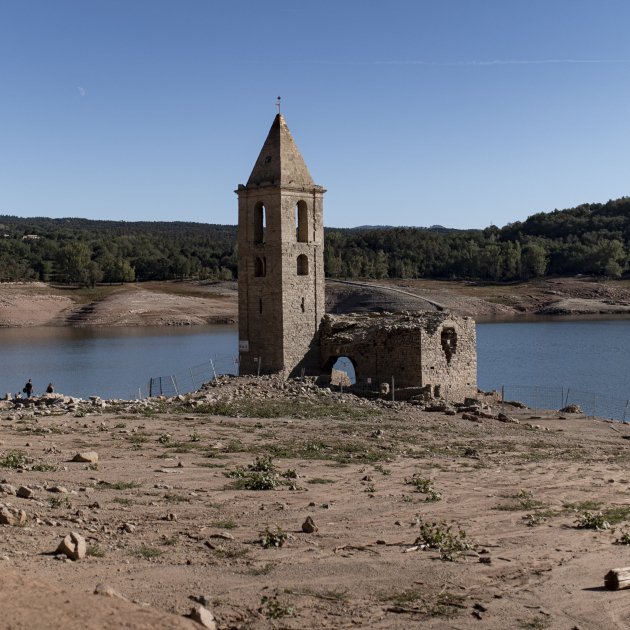It remains only a matter of time - days, probably - until Barcelona's metropolitan area enters into a drought emergency, the most severe of the five levels of drought status. This week, an expected declaration of emergency status in the Ter-Llobregat catchment system, which takes in most of Catalonia's highly-populated central coastal area, has been postponed, since that system (ATL) has remained at 16.5% capacity, half a point above the threshold provided for in the drought plan. So, for the moment Barcelona and most of its surrounding metropolitan area (see map below) remains in pre-emergency.
However, the total of the nine reservoirs of Catalonia's internal basins - taking in the eastern half of Catalonia - dropped below 16% of its capacity for the first time this Thursday (15.99%), according to data from the Catalan Water Agency (ACA). This is bad news, but symbolic, as the emergency declaration is implemented individually based on the levels in each of the units that make up the internal basins. The Ter-Llobregat system (ATL), which remains just above the threshold, supplies high-flow drinking water (that which is transported through large-diameter pipes) to more than 100 municipalities in the regions of Alt Penedès, Anoia, Baix Llobregat, Barcelonès, Garraf, Maresme, Selva, Solsonès, Vallès Oriental and Vallès Occidental counties, which contain a population of around 5 million people.
The internal basin reservoirs, a sad spectacle
The internal basins of Catalonia, where the ACA has full powers, group together the eastern side of the Catalan hydrographic network (coloured on the map below). They include the rivers that originate within Catalonia and flow eastwards into the Mediterranean, all within Catalonia: they are the basins of the rivers Muga, Fluvià, Ter, Daró, Tordera, Besòs, Llobregat, Foix, Gaià, Francolí and Riudecanyes, and the coastal streams between the border with France and the drainage of the Sénia river. The nine reservoirs that make up the internal basins are Darnius-Boadella, Sau, Susqueda, la Baells, la Llosa del Cavall, Sant Ponç, Foix, Siurana and Riudecanyes.
The Sau reservoir is at its historical minimum, at 4.8%, an unfortunate milestone that it also shares with Darnius-Boadella, now at 12.1%, and that of Riudecanyes, with 2.9% of its total water capacity. The rest of the reservoirs also continue to recede. That of Siurana, which stands at 3.4%, very close to the historical minimum of the year 2000 (0.9%). Llosa del Cavall is also falling, with 17.2% of reserves, getting closer to its minimum value, recorded during the drought of 2008 (12%). Baells, at 21.2%, also falling, is already practically at the levels of the drought of a decade and a half ago (20.4%) and that of 2005 (18.7%). Only three of the nine reservoirs have registered slight increases in volume in recent months: Foix, which is far from the minimum recorded in September of last year (47.6%) and already exceeds 56%. Susqueda is at 21.2%, a value higher than the minimum of 17.8% in November 2023, and Sant Ponç has risen from 26% to 27.6% in the last three months.
The Ter Llobregat system (ATL)
Most of the metropolitan area, as well as an area to the north of it, reaching Girona, is part of the Ter Llobregat system (ATL). It is supplied with regulated water from six reservoirs: Baells, Llosa del Cavall and Sant Ponç in the Llobregat basin and Sau, Susqueda and the Pasteral reservoir, in the Ter basin (Girona). Currently, this system also receives desalinated seawater from the Llobregat (El Prat de Llobregat) and Tordera (Blanes) plants. The distribution network managed by ATL has more than 1,000 kilometres of pipes, more than 60 pumping stations and covers an area of 2,455 km². Once it leaves the head deposits of each population, the responsibility for distribution to homes is the responsibility of each municipality. Currently, the reserves of the ATL system are at 16.5%, only half a point above the threshold of the state of emergency decreed by the drought plan. In turn, the unit that depends on the Darnius-Boadella reservoir - in the far north-east of Catalonia, largely red on the map - has been in emergency for months and reserves are now at 12.1%.
And the rest? The western areas of Catalonia, grey on the map above, have catchments and waterways that run into the major Ebre river, running west-east from its origin in the Picos de Europa to the Delta in the south of Catalonia, and all of these are managed by the Ebro Hydrographic Confederation (CHE), which in December reported a slight improvement in the situation of some of its Catalonia basins, but the situation in the Segre basin has been dramatic ever since it first entered emergency status in June 2022.
It is more than three years since the drought in Catalonia began.
